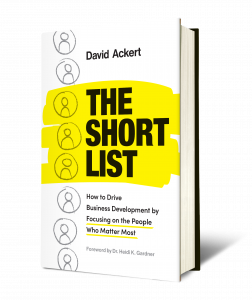As a professional services firm marketer or business developer, one of the many hats you may wear is that of a business development coach. It’s a crucial role and, if played well, can contribute significantly to your department’s success.
For more than 20 years, Ackert has been providing comprehensive business development coaching programs to professional services firms and has worked with some of the finest in-house coaches as well. Our years of experience have proven that the following top 10 simple tips are crucial for being a world-class business development coach:
1. Consider yourself a revenue-builder.
You may not be qualified to practice law, accounting, engineering, financial planning, or consulting, but you do bring a unique set of skills to the table that your coaching subjects do not: the strategies and skills to build revenue.
2. Come to the table with confidence.
Build trust and establish credibility by confidently positioning yourself as an expert in marketing, business development, and communications that often intimidate seller-doers. Feel empowered to share your insights and perspectives. Nobody wants to be coached by someone who doesn’t appear to be sure of themselves.
3. Know when to use reactive vs. proactive coaching.
As a valued marketing and business development resource, sell-doers will often rely on you to provide encouragement and expertise to meet a short-term need. While reactive coaching moments are necessary, it’s your job to also proactively coach seller-doers, so they continue to realize growth and skills improvement. Often, the reactive coaching moments help to build your credibility and confidence for proactive coaching opportunities.
4. Stop trying to coach the un-coachable.
Don’t waste your time on seller-doers who aren’t committed to continuous improvement and constructive criticism. Look for those who are eager and determined to learn and grow.
5. Be prepared to overcome common objections.
Seller-doers will raise objections, and it’s your responsibility to help them remove their real or perceived hurdles as quickly and efficiently as possible. Seller-doers typically present the same few challenges, again and again, so don’t waste precious time waiting to hear them before figuring out how to help them overcome them.
6. Keep your coaching collaborative.
Instead of simply teaching, ask questions and allow the coachee to discover their own answers. Coaching is a journey, and you are there to facilitate seller-doers helping themselves.
7. Demonstrate you offer more than concierge service.
Sure, you have to accommodate when seller-doers have one-off, time-sensitive requests. But whenever possible, ask questions that prompt seller-doers to want to grow and improve and then demonstrate how you can help them over the long term.
8. Know the difference between training and coaching and when to use each.
Training is used when someone simply needs to learn how to do something. On the other hand, coaching is working with a coachee to determine why they’re not doing something they already know how to do. It’s an important distinction.
9. Acknowledge the importance of chemistry.
No matter how highly skilled a coach you are, a coach and coachee relationship simply won’t work without chemistry. Make sure you have compatible backgrounds and that your coaching approach resonates with how they prefer to learn.
10. Provide tools that enable success and track results.
Every job is easier with the right tools, and seller-doers are motivated by results. With the right technology, seller-doers can stay on track with their business development activities, revisit best practices and see the results of their efforts.
The PIPELINEPLUS sales acceleration platform combines sales pipeline management, AI-driven reminders, e-learning micro-lessons on every stage of business development, and reporting and analytics all on one easy-to-use platform accessible on laptop, desktop, or mobile.







